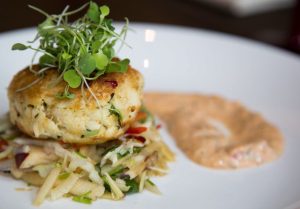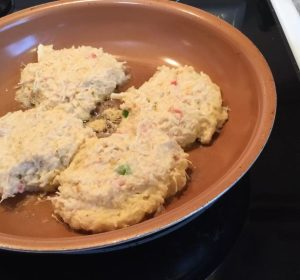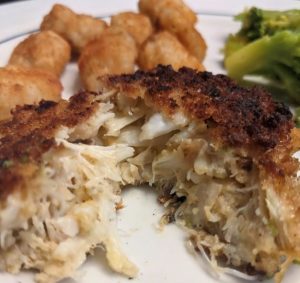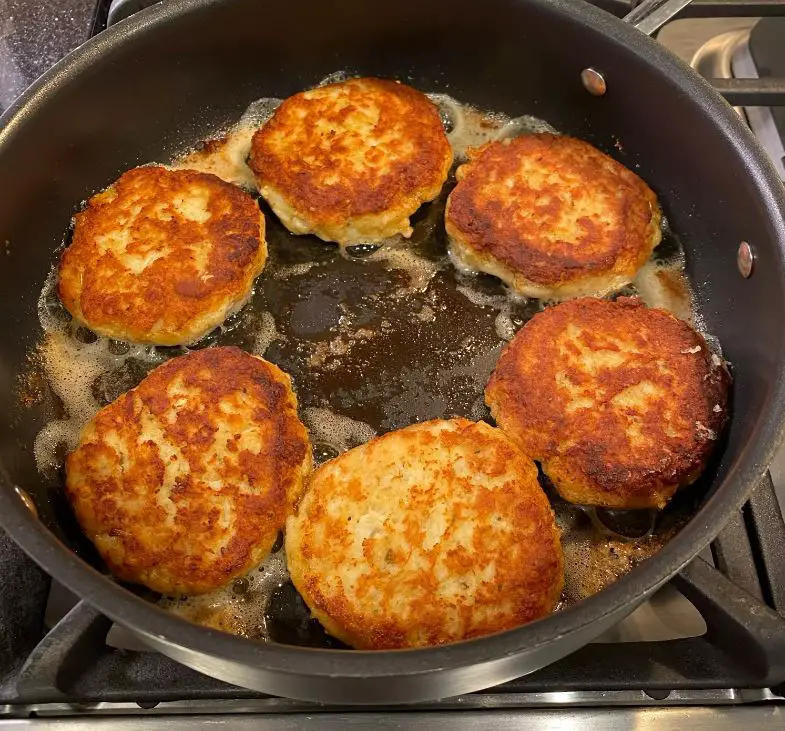Introduction to Crab Cakes
Crab cakes, a staple in seafood cuisine, are celebrated for their rich flavor and delicate texture. Originating from the Chesapeake Bay, they have evolved into a beloved dish worldwide, adaptable to various culinary styles.
The Popularity of Crab Cakes
Crab cakes have captivated food enthusiasts globally, thanks to their exquisite taste and versatility. Their charm lies in the delicate balance of flavors, highlighting the crab’s natural sweetness. The adaptability of crab cakes is key to their popularity. They can be seasoned and served in countless ways, making them a favorite in both casual and fine dining. This versatility extends to their preparation methods too, be it pan-fried for a crispy exterior or baked for a healthier option. The simplicity of their ingredients allows the crab meat to shine, while also providing a canvas for culinary creativity. From the classic Maryland crab cake, focusing on the purity of crab meat, to more adventurous versions incorporating unique spices and herbs, crab cakes offer a delightful experience to every palate.
Overview of Different Styles
Crab cakes vary widely in style, influenced by regional tastes and ingredients. In Maryland, the emphasis is on the crab meat’s quality, often using minimal filler and traditional seasonings like Old Bay. In contrast, other regions might incorporate local flavors, like the Cajun spices in Louisiana, offering a bolder taste. The Pacific Northwest might showcase Dungeness crab, prized for its sweet flavor, in their crab cakes. These regional variations not only demonstrate the adaptability of crab cakes but also their ability to resonate with diverse culinary traditions.
Selecting the Right Crab Meat
The foundation of a great crab cake is the quality of the crab meat used. The choice of crab meat significantly influences the texture and flavor of the cake.
Types of Crab Meat: Lump vs. Jumbo Lump
In crab cakes, the type of crab meat used can make a significant difference. Lump crab meat, known for its fine texture and sweet flavor, is a popular choice. It blends well with other ingredients while maintaining its distinct crab taste. Jumbo lump crab meat, prized for its large, meaty pieces, is ideal for a more luxurious crab cake. It offers a more pronounced crab flavor and a tender, succulent texture, making it a favorite for gourmet preparations. The choice between lump and jumbo lump often depends on personal preference and the desired outcome of the dish.
Fresh vs. Canned Crab Meat
Choosing between fresh and canned crab meat is another crucial decision. Fresh crab meat, with its superior flavor and texture, is preferred for its authenticity and freshness. However, it requires careful handling and quick usage. Canned crab meat, while more convenient and with a longer shelf life, can vary in quality. High-quality canned crab can still produce delicious crab cakes, especially when combined with the right ingredients. The key is to select canned crab meat that retains the natural flavor and texture of the crab.

Essential Ingredients for Crab Cakes
The magic of crab cakes lies in the harmony of their ingredients, with each playing a crucial role in enhancing the crab’s natural flavor.
Binding Ingredients: Eggs and Mayonnaise
Eggs and mayonnaise are essential in crab cakes, acting as binders that hold the mixture together. Eggs provide structure and help in forming the cakes, ensuring they don’t fall apart during cooking. Mayonnaise adds moisture and richness, complementing the crab’s flavor without overpowering it. The proportion of these ingredients is key; too much can make the cakes heavy, while too little might not bind them effectively. The goal is to achieve a balance where the crab meat remains the star, and the texture is light and moist.
Flavor Enhancers: Mustard, Worcestershire Sauce, and Spices
Mustard, Worcestershire sauce, and spices are vital for adding depth and complexity to crab cakes. Mustard brings a tangy sharpness, cutting through the richness of the crab and mayonnaise. Worcestershire sauce adds umami and a subtle hint of spice. Spices, like Old Bay seasoning, paprika, or cayenne pepper, can be adjusted according to taste. They should enhance the crab flavor, not overpower it. The right combination of these flavor enhancers can elevate a simple crab cake into a gourmet experience, creating a perfect harmony of tastes that complements the delicate flavor of the crab.
The Role of Fillers in Crab Cakes
Fillers in crab cakes play a crucial role in texture and cohesion, but their use must be balanced to maintain the crab’s prominence.
Bread Crumbs vs. Panko
Choosing between bread crumbs and panko can significantly affect the texture of crab cakes. Traditional bread crumbs offer a finer texture, resulting in a more compact cake. They absorb moisture well, which can be beneficial for holding the cake together but may lead to a denser texture if overused. Panko, Japanese-style bread crumbs, are larger and more flaky. They create a lighter, airier crab cake with a crisper exterior. Panko doesn’t absorb as much moisture, allowing the crab flavor to stand out more. The choice between bread crumbs and panko depends on the desired texture and the specific recipe.
Balancing Fillers with Crab Meat
The key to perfect crab cakes is balancing the fillers with the crab meat. Fillers should never overpower the crab; instead, they should complement and enhance it. The right proportion of filler to crab meat is essential. Too much filler can mask the delicate flavor of the crab, while too little may not provide enough structure. The goal is to achieve a balance where the crab remains the star, and the fillers add just enough body and texture to hold the cake together while enhancing its overall flavor.
Step-by-Step Crab Cake Preparation
Creating crab cakes involves a careful process to ensure the best flavor and texture.
Mixing Ingredients
The first step in making crab cakes is to gently mix the ingredients. Start by combining the binding agents like eggs and mayonnaise with the flavor enhancers such as mustard, Worcestershire sauce, and spices. Once these are well mixed, carefully fold in the crab meat and fillers. It’s important to mix gently to avoid breaking up the crab meat too much, which can affect the texture of the cakes. The mixture should be uniform but not overworked.
Forming the Cakes
Once the mixture is ready, the next step is forming the cakes. This can be done by hand or with the help of a mold. The size of the cakes can vary, but they should be consistent for even cooking. It’s important not to compact the cakes too tightly; they should be just firm enough to hold together. If the mixture is too loose, a little more filler can be added. Once formed, the crab cakes can be chilled for a short time to help them set, making them easier to cook without falling apart.
Cooking Techniques for Crab Cakes
The cooking method chosen for crab cakes can influence their flavor and texture.
Pan-Frying for a Crispy Exterior
Pan-frying is a popular method for cooking crab cakes, offering a crispy exterior and a tender interior. To pan-fry crab cakes, heat a moderate amount of oil in a skillet over medium heat. Once hot, add the crab cakes, cooking them until they are golden brown and crispy on each side. This method creates a delightful contrast in textures, with a crunchy outside and a moist, flavorful inside. The key is to not overcrowd the pan and to turn the cakes gently to prevent them from breaking apart.
Baking as a Healthier Alternative
Baking is a healthier alternative to frying and is ideal for those looking to reduce oil in their diet. To bake crab cakes, preheat the oven and place the cakes on a lightly greased baking sheet. Baking them at a high temperature for a short duration helps to achieve a slightly crispy exterior while keeping the inside moist. This method is less hands-on than pan-frying and can be more convenient for larger batches. While baking may not provide the same level of crispiness as frying, it results in a lighter, more delicate crab cake.

Regional Variations of Crab Cakes
Crab cakes vary significantly across different regions, each bringing its unique twist to this classic dish.
Maryland Style Crab Cakes
Maryland style crab cakes are renowned for their simplicity and focus on the crab meat. These cakes typically use minimal filler, allowing the sweet, delicate flavor of the crab to shine through. The seasoning is often straightforward, with Old Bay seasoning being a traditional choice. Maryland crab cakes are usually pan-fried, creating a crispy exterior that contrasts beautifully with the tender, moist interior. This style is a testament to the philosophy that less is more, where the quality of the crab meat is the star of the show.
Other Regional Takes
Other regions have their unique takes on crab cakes. In Louisiana, for instance, crab cakes might include Creole or Cajun seasonings, adding a spicy kick. In the Pacific Northwest, Dungeness crab is often used, known for its sweet, tender meat. These regional variations might also include different types of fillers or binding ingredients, reflecting local tastes and culinary traditions. Some regions might serve their crab cakes with unique sauces or sides, further distinguishing their version from others. These regional differences showcase the versatility of crab cakes and how they can be adapted to suit different palates and ingredients.
Dietary Adaptations
Adapting crab cakes to suit various dietary needs has become increasingly popular, ensuring everyone can enjoy this delicious dish.
Gluten-Free Substitutes
For a gluten-free version, traditional bread crumbs can be replaced with gluten-free alternatives like crushed gluten-free crackers, almond flour, or coconut flour. These substitutes can mimic the texture of regular bread crumbs while keeping the dish gluten-free. It’s also important to ensure that all other ingredients, such as seasonings and sauces, are gluten-free.
Making Keto-Friendly Crab Cakes
To make crab cakes keto-friendly, high-carb fillers need to be substituted with low-carb alternatives. Almond flour or crushed pork rinds can be excellent choices, providing the necessary binding without adding carbs. Additionally, other ingredients should be checked to ensure they fit within the keto dietary guidelines. These adaptations allow those on a keto diet to enjoy crab cakes without breaking their carb limit.
Tips for Making Crab Cakes Ahead of Time
Crab cakes can be prepared in advance, making them a convenient option for meals.
Storage and Refrigeration
To store crab cakes before cooking, shape them and place them on a baking sheet lined with parchment paper. Cover them with plastic wrap and refrigerate. This can be done up to a day in advance. For longer storage, crab cakes can be frozen. Place them in the freezer on the baking sheet until solid, then transfer to a freezer-safe container or bag. They can be stored in the freezer for up to three months.
Reheating Without Losing Quality
To reheat pre-cooked crab cakes, it’s best to use an oven or toaster oven. Preheat the oven to a moderate temperature and place the crab cakes on a baking sheet. Heat them until they are thoroughly warmed through. This method helps maintain the texture and moisture of the crab cakes. If they were frozen, it’s recommended to thaw them in the refrigerator overnight before reheating. This ensures even warming and preserves the quality of the crab cakes.
Understanding the Nutritional Value of Crab Cakes
Crab cakes can be a nutritious addition to a balanced diet, depending on their preparation and ingredients.
Caloric Content and Nutritional Breakdown
The nutritional value of crab cakes varies based on the ingredients and cooking method. Generally, crab meat is a good source of protein and contains essential nutrients like Vitamin B12 and selenium. However, the caloric content can increase with the addition of fillers, binding agents, and cooking methods like frying. A typical crab cake may contain calories ranging from moderate to high, so it’s essential to consider the ingredients used.
Making Healthier Crab Cake Choices
To make healthier crab cakes, opt for low-calorie fillers like panko or almond flour, use light mayonnaise or yogurt as binders, and include plenty of herbs and spices for flavor without added fat. Baking or grilling instead of frying can also reduce the calorie count. By making these adjustments, crab cakes can be a healthier option that still delivers on flavor and satisfaction.

How To Make Crab Cakes
Crab cakes are a classic seafood dish known for their rich flavor and tender texture. Here’s a recipe for making delicious crab cakes:
Ingredients:
- 1 pound lump crab meat, carefully picked over for shells
- 1/4 cup breadcrumbs or cracker crumbs
- 1/4 cup mayonnaise
- 1 egg
- 1 tablespoon Dijon mustard
- 1 tablespoon Worcestershire sauce
- 1 teaspoon Old Bay seasoning
- 1/4 cup finely chopped parsley
- 1/4 cup finely chopped green onions
- Juice of half a lemon
- Salt and pepper to taste
- Olive oil or butter for frying
Directions:
- Combine Wet Ingredients:
- In a large bowl, whisk together the mayonnaise, egg, Dijon mustard, Worcestershire sauce, and lemon juice.
- Add Seasonings:
- Stir in the Old Bay seasoning, chopped parsley, green onions, salt, and pepper.
- Incorporate Crab Meat and Breadcrumbs:
- Gently fold in the crab meat and breadcrumbs into the mixture. Be careful not to overmix or break up the crab meat too much.
- Form Crab Cakes:
- Shape the mixture into patties. You can make them the size you prefer, but typically, they should be about 1/2 inch thick.
- Chill:
- Place the crab cakes in the refrigerator for at least 30 minutes. This step helps them hold together better when cooking.
- Cook the Crab Cakes:
- Heat a few tablespoons of olive oil or butter in a large skillet over medium heat.
- Once hot, add the crab cakes and cook for about 4-5 minutes on each side, or until they are golden brown and crispy.
- Serve:
- Serve the crab cakes hot with lemon wedges and a dipping sauce, such as tartar sauce, remoulade, or a simple aioli.
Tips:
- Be gentle when mixing and shaping the crab cakes to keep the crab meat in nice lumps.
- If the mixture seems too wet, you can add a little more breadcrumbs. If it’s too dry, add a bit more mayonnaise.
- For an extra crispy exterior, you can lightly coat the crab cakes in additional breadcrumbs before frying.
- Crab cakes can also be baked for a healthier option. Place them on a lined baking sheet and bake in a preheated 400°F (200°C) oven for about 10-15 minutes or until golden brown.
Enjoy your homemade crab cakes as a delicious appetizer or main course, perfect for impressing guests or treating yourself to a gourmet seafood experience!
FAQs About Crab Cakes
Is crab cake made of crab?
Yes, crab cakes are primarily made of crab meat. They typically combine crab meat with various ingredients like breadcrumbs, eggs, and seasonings to form patties. The quality and type of crab meat used significantly influence the flavor and texture of the crab cakes.
Are crab cakes better baked or fried?
Whether crab cakes are better baked or fried depends on personal preference. Baking offers a healthier option with a lighter texture, while frying provides a crispier exterior. Both methods can yield delicious results, with the choice often depending on dietary preferences and desired texture.
What keeps crab cakes from falling apart?
To prevent crab cakes from falling apart, binding ingredients like eggs and breadcrumbs are essential. They help hold the crab meat together. The mixture’s consistency, careful handling, and proper cooking techniques also play crucial roles in maintaining the integrity of crab cakes.
What are the two types of crab cakes?
The two main types of crab cakes are Maryland-style and Boardwalk-style. Maryland-style crab cakes focus on minimal filler, highlighting the crab’s flavor, while Boardwalk-style crab cakes have more fillers, resulting in a cake-like consistency. Both styles offer distinct textures and flavors.
Conclusion
Crab cakes, a versatile and beloved seafood dish, offer a delightful culinary experience. From the classic Maryland style to innovative keto-friendly versions, they can be adapted to suit various tastes and dietary needs. By understanding the ingredients and cooking methods, one can enjoy crab cakes in a way that balances indulgence with health, making them a fitting choice for any occasion.


